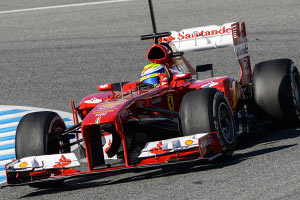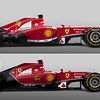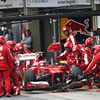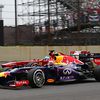Ferrari F138

Active: 2013
Team: Scuderia Ferrari SpA
Team: Pat Fry (TD), Nikolas Tombazis (CD), Stefano Domenicali (MD), Simone Resta (DTD), Corrado Lanzone (Head of production)
Drivers: Fernando Alonso (3), Felipe Massa (4)
The F138 is the fifty ninth car built by Ferrari specifically for Formula One. It was launched at Maranello on February 1. The name comes from a combination of the current year and the number of cylinders, to mark the fact that this is the eighth and final year of competition for the V8 engine configuration.
The project, which goes by the internal code name 664, is the first design to come from the reorganisation concerning working methods that has been in operation for several months, with the creation of two distinct groups of designers: one working on this car and the other on the completely different car which will race next season. This car constitutes the Scuderia’s interpretation of this year’s Technical and Sporting Regulations, which in fact are substantially the same as those from last season. Therefore the F138 can be seen as an evolution of the F2012, in terms of its basic design principals, although every single part has been revised in order to maximise performance, while maintaining all the characteristics which were the basis of last season’s extraordinary reliability.
The design philosophy of the suspension layout has not changed and it continues to use pull-rods both front and rear, but it has been refined to the limit, in order to gain as much aerodynamic advantage as possible, especially at the rear. The bodywork elements have been redesigned to allow for changes to the positioning and layout of the exhausts. The dynamic air intake, mounted above the cockpit has been redesigned, as have been the intakes to the side pods, which in turn have also been optimised in aerodynamic terms, while maintaining unchanged the overall cooling system.
The rear of the car is much narrower and more tapered on the lower part. The configuration of the front and rear wings derives directly from the last versions used on the F2012, partly because development of that car ran all the way to the final race of last season. However, the aerodynamic elements shown on the car are only those from the initial phase of development: significant modifications will be introduced in the weeks leading up to the first race and a busy development programme is already planned. The drag reduction system on the rear wing has been revised and optimised to make the most of the modifications to the Sporting Regulations that come into play this year. There are detailed changes to the design of the brake ducts, both front and rear and work has been carried out with Brembo on optimising the braking system overall. During both the design and production stages, great attention has been paid to weight reduction and on increasing rigidity. This theme was carried out through all departments working together – Chassis, Engine and Electronics and Production – which bears witness to the importance of being able to design and build a car with everyone working side by side in the same place, which has always been the case at Ferrari.
The engine on the F138 is an evolution of the one fitted to the car last year, inevitably given that the technical regulations forbid modifications to internal components aimed at improving performance. Given the consequent difficulty of finding performance increases through internal modifications, work was intensified on ensuring that the engine’s performance level remained as high as possible throughout the lifecycle of each power unit, which has now reached an average life of three races.
The kinetic energy recovery system retains its location in the lower-central part of the car, a strategic choice which has always been adopted by the team, partly with the aim of ensuring maximum safety. Once again this year, a great deal of effort has gone into reducing its weight and size, at the same time improving the efficiency of some of its components and, as in the case of the engine, maintaining the highest performance level throughout the KERS usage cycle. The technical collaboration with Shell, which has run for several decades now, has led to further progress on the fuel and lubricants front, aimed at increasing performance in overall terms and also on maintaining it throughout the engine’s life, as well as reducing consumption.
As for the electronics, it is worth noting the introduction, ahead of schedule, of the single control unit that will be used in 2014. This has involved a lot of work to integrate and control all its features in terms of both software and hardware.
In keeping with a Ferrari tradition, much time has been dedicated to the performance and improvement of the materials used, at the design stage of each of the six thousand or so components which make up the car, in order to make all the on-track work more effective and efficient. Obviously, quality control remains a vital aspect, with the aim of achieving the highest levels of performance and reliability, at the same time as maintaining the highest safety standards possible.
With only twelve days of testing available before the start of the Championship, the preparatory work on the test benches prior to the car’s track debut, has taken on even more importance. The three test sessions – at Jerez de la Frontera and Barcelona – will allow the team to get to understand the behaviour of the F138 and to adapt it to the new Pirelli tyres: in fact, tyre use is an area that has seen a lot of work both at the design stage and in its management at the track. Also very important and something that will not only be restricted to the winter months, has been the effort invested in areas that could influence the result of a Grand Prix, such as the team’s pit stop work, reduction of time spent going through the pit lane, strategy management and the start procedure.
Also see:
- Ferrari F138 technical analysis
- Q+A with Pat Fry, Ferrari technical director
- Chief designer Tombazis explaining the team restructuring process
Specifications
Chassis: Carbon-fibre and honeycomb composite structure
Differential: Limited-slip
Gearbox:Semiautomatic sequential electronically controlled gearbox – quick shift, 7 gears +Reverse, longitudinally mounted
Brakes: Brembo ventilated carbon-fibre disc brakes
Suspension: Independent suspension, pull-rod activated torsion springs front and rear
Weight: with water, lubricant and driver: 642 kg
Wheels: OZ (front and rear): 13”
Engine
Designation: Ferrari typo 056
Configuration: Naturally aspirated V8, 2398 cm³; cylinder block in sand cast aluminium V 90°
Valves: 32
Distribution: Pneumatic distribution
Piston bore: 98 mm
Weight: > 95 kg (minimum according to regulations)
Injection: Electronic injection and ignition
Fuel: Shell V-Power
Lubricant: Shell Helix Ultra







